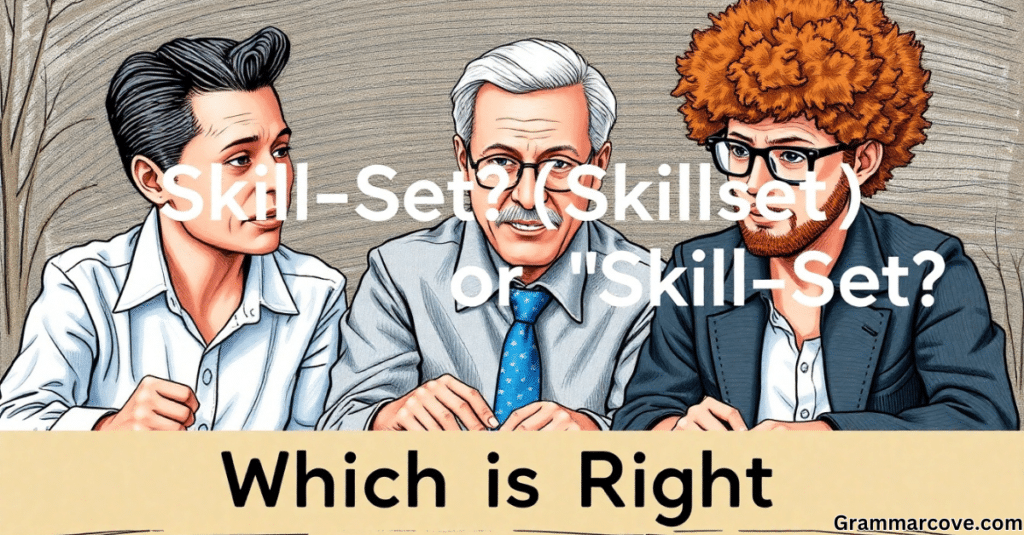Language, in all its complexity, can be tricky. While English is flexible and dynamic, this often leads to confusion—especially when it comes to terms that seem synonymous but have subtle differences. One such term is “skill set”. You’ve probably encountered variations like “skillset” or “skill-set” as well. But how do you know which one is right?
This article will dissect these three forms—“skill set,” “skillset,” and “skill-set”—and help you understand when and where to use them. By the end, you’ll be well-equipped to use these terms confidently, whether you’re writing a professional email, a resume, or creating job descriptions.
What Exactly is a “Skill Set”?
Before we dive into the variations of the term, it’s important to understand what a skill set is. A skill set refers to a collection of abilities, competencies, and knowledge that someone possesses. These can be specific, like technical skills such as coding, or more general, like soft skills such as communication or leadership.
In today’s competitive job market, skill sets are essential for differentiating one candidate from another. They’re not just about what you can do—they’re about the abilities you bring to a team, job, or project. The phrase is used in many professional contexts, especially in resumes, job descriptions, and performance reviews.
Scenario Example: Skill Set in a Job Posting
Imagine browsing through a job posting. You come across this description:
“We’re looking for a marketing specialist with a skill set that includes SEO expertise, content strategy, and proficiency in Google Analytics.”
In this case, skill set is used to refer to the range of competencies the employer is seeking from candidates. It’s clear and straightforward.
“Skillset” vs “Skill Set”: What’s the Difference?

Now that we know what a skill set is, let’s discuss the different forms you’ll encounter: skill set, skillset, and skill-set.
The Two-Word Version: Skill Set
The two-word version—skill set—is considered the most traditional and grammatically correct version, according to style guides like the Chicago Manual of Style. This form is widely used in formal, professional, and academic settings.
In formal writing, such as business reports, academic papers, or corporate communication, you’ll want to stick to this version. It’s neat, clear, and well-established.
Scenario Example: Formal Email
Here’s how you might use skill set in a formal email:
Subject: Job Applicant – Sarah T.
Dear Mr. Johnson,
I hope this email finds you well. After reviewing Sarah T.’s resume, I believe her skill set is well aligned with the position of Marketing Manager. Her experience in SEO, content creation, and digital marketing would be a great asset to our team.
Best regards,
Anna Williams
In this email, the two-word version skill set is used because the tone is formal, and the context calls for clarity and professionalism.
The One-Word Version: Skillset
While the two-word version remains more traditional, the one-word form, skillset, has become increasingly popular in informal contexts, particularly in the digital age. Skillset is common in social media posts, job descriptions, resumes, and other modern business writing.
In casual writing, like emails between colleagues or in certain job postings, skillset is generally acceptable. It’s faster to type and can lend a more conversational tone to your writing.
Scenario Example: Job Description
A company might use skillset in a job posting like this:
Job Title: Digital Marketing Specialist
Required Skillset:
- Expertise in SEO
- Strong communication and writing skills
- Proficiency in Google Analytics and AdWords
This use of skillset helps the job posting appear more modern and approachable, reflecting a conversational tone.
The Hyphenated Version: Skill-Set
You might also see skill-set used in more traditional contexts or in older publications. The hyphenated form was more common in the past, but it has largely fallen out of favor in favor of the two-word version. It is still acceptable in certain settings, particularly in formal business or academic writing, though it’s less commonly used today.
The hyphenated form is still seen in print media, older textbooks, and some style guides that adhere to older grammatical conventions.
Scenario Example: Older Business Document
Let’s consider an older business memo:
“The ideal candidate should possess a well-rounded skill-set that includes proficiency in digital marketing, content development, and SEO best practices.”
In this case, skill-set was likely used to adhere to older standards of professional writing.
Skill Set Grammar: Singular vs. Plural
A key aspect of using “skill set” (or its variations) correctly is understanding whether to use the singular or plural form.
- Singular: You use the singular form skill set when referring to one collection of abilities.
- Plural: You use the plural form skill sets when referring to multiple collections of abilities, as in the case of different individuals or teams.
Examples:
- Singular:
“Her skill set includes proficiency in graphic design, video editing, and social media management.”
- Plural:
“The skill sets of our team members vary widely, from technical expertise to creative abilities.”
Understanding when to use the singular vs. plural form helps avoid mistakes in more complex writing.
Skill Set Terminology: Key Competencies, Expertise, and Proficiencies

When discussing skill sets, you’ll encounter several related terms that are often used interchangeably. However, there are subtle distinctions between these terms. Let’s define a few:
- Competencies: These are the skills or abilities required to perform a job or task. Competencies may include both technical skills (like using a software program) and soft skills (like leadership).
- Expertise: This refers to a high level of knowledge or skill in a specific area. Someone with expertise has mastered a particular domain, such as data science or network security.
- Qualifications: These are the credentials or formal education that demonstrate your expertise. For instance, a degree in computer science or certification in project management.
- Proficiencies: These are specific abilities that someone has learned to perform well, such as proficiency in a foreign language or Excel.
These terms all relate to skill sets, but each has a distinct meaning. You might encounter them when discussing resumes, job applications, and career development.
Scenario Example: Resume
Let’s take a look at how you might incorporate these terms in a resume:
Skill Set:
- Proficiency in Microsoft Office Suite, including advanced Excel skills
- Expertise in search engine optimization (SEO) and content marketing
- Competencies in project management and team leadership
By listing both your competencies and expertise, you create a more detailed and compelling description of your skill set.
Skill Set in Job Postings: How Employers Use It
Employers commonly list the required skill set for a position to help candidates understand the job’s demands. A well-crafted job description will specify the skills, qualifications, and expertise needed.
In modern job postings, it’s common to see a bulleted list outlining the desired skill set. These can range from technical abilities (like proficiency in programming languages) to soft skills (like communication or time management).
Scenario Example: Skill Set in Job Postings
Here’s how a job description might appear:
Position: Software Engineer
Required Skill Set:
- Proficiency in Java, Python, and C++
- Strong knowledge of algorithms and data structures
- Expertise in cloud computing platforms (AWS, Azure)
- Excellent communication and problem-solving skills
In this example, the employer lists both technical and soft skills, creating a comprehensive picture of the skill set required for the position.
British English vs American English: Regional Preferences
When it comes to skill set, there are subtle differences in British and American English. Both versions accept the two-word form “skill set”, but there are regional variations in usage:
- American English: The two-word version is most common, though skillset (one word) is widely used in informal writing.
- British English: Skill-set (hyphenated) was once preferred, though the two-word form is increasingly common.
Scenario Example: British vs American Job Posting
Here’s how a British company might phrase a job requirement:
“The ideal candidate should have a strong skill-set in digital marketing, with a particular emphasis on SEO and content creation.”
An American version might look like this:
“We’re seeking a candidate with a skill set in digital marketing, including SEO, content writing, and email campaigns.”
Table: Skill Set Forms Comparison
| Form | Usage | Context | Examples |
|---|---|---|---|
| Skill Set | Most traditional, formal | Academic, business, professional communication | “Her skill set includes data analysis and reporting.” |
| Skillset | Informal, modern usage | Job descriptions, resumes, casual emails | “His skillset in marketing is impressive.” |
| Skill-set | Older, formal, rarely used today | Older publications, historical documents | “The candidate’s skill-set is quite diverse.” |
Style Guides on Skill Set: Which Should You Follow?
Different style guides can influence whether you choose skill set, skillset, or skill-set. Here are some key style guides and their preferences:
- Chicago Manual of Style: Prefers “skill set” (two words) for formal writing.
- APA Style: Also favors the two-word version, aligning with grammatical standards.
- Merriam-Webster Dictionary: Accepts both “skill set” and “skillset”, with a slight preference for the two-word version.
While some modern trends lean towards skillset (one word), it’s safe to follow traditional style guides for professional writing, especially when communicating with more formal audiences.
Conclusion: Which is Right?
In conclusion, the right version depends on the context, audience, and tone of your writing. Here’s a quick summary of the best practices:
- Skill set (two words) is the traditional, grammatically correct version, ideal for formal writing and business communication.
- Skillset (one word) is commonly used in informal contexts, such as job postings and social media.
- Skill-set (hyphenated) was used more in older texts but is largely out of fashion today.
Ultimately, the key is to choose the version that aligns with the formality of your writing and the expectations of your audience. Whether you’re drafting a resume, crafting a job description, or emailing a colleague, understanding the nuances of these variations will help you write with clarity and confidence.


